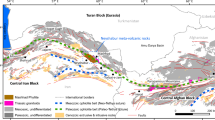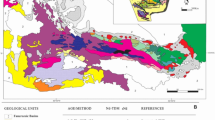Abstract
Submarine volcanic rocks dredged during RV Meteor cruise M43-1 comprise alkali basalts, basanites, nephelinites and their differentiates representing both basement-shield and young post-shield volcanics of Gran Canaria, Tenerife, La Palma and El Hierro. The primitive lavas vary widely in trace element composition (e.g., Zr/Y=6.6–11.7, (La/Sm)N=2.3–5.4, and Ba/Yb=71–311), and they are characterized by steep, rare-earth element patterns with mean (La/Yb)N=16, and by pronounced, positive primitive mantle-normalized Nb and Ta and negative K anomalies similar to HIMU-type basalts. Rocks from the submarine flanks west and north of Gran Canaria are isotopically and geochemically identical to rocks of the subaerial Miocene shield stage, but they are distinct from rocks of the post-shield stages (Zr/Nb=6.3–8.9, 87Sr/86Sr=0.70327–0.70332, 143Nd/144Nd=0.51289–0.51293, 206Pb/204Pb=19.55–19.88). Most rocks dredged from the submarine flanks of Tenerife are isotopically and geochemically similar to rocks of the adjacent subaerial shield remnants, but a few resemble rocks of the subaerial post-shield stages (total range in Zr/Nb=4.6–6.1, 87Sr/86Sr=0.70300–0.70329, 143Nd/144Nd=0.51281–0.51292, 206Pb/204Pb=19.51–19.96). Rocks from the southern submarine ridge of La Palma cover the entire compositional range of the subaerial rocks of that ridge. Additionally, they comprise a high Zr/Nb group which resembles rocks of the ca. 1-Ma-old Taburiente shield of northern La Palma (total range in Zr/Nb=3.0–6.4, 87Sr/86Sr=0.70297–0.70314, 143Nd/144Nd=0.51288–0.51296, 206Pb/204Pb=19.21–19.79). Rocks from the southern submarine ridge of El Hierro compositionally resemble subaerial rocks of the island (Zr/Nb=4.1–6.2, 87Sr/86Sr=0.70296–0.70314, 143Nd/144Nd=0.51291–0.51297, 206Pb/204Pb=19.25–19.91). The degree of melting in the subcanarian mantle is interpreted to decrease from east to west across the archipelago whereas the proportion of depleted mantle component in the melting anomaly increases, as illustrated by Sr, Nd and Pb isotopes. The isotopic characteristics of the mantle source beneath the Canary Islands represents a mixture of HIMU, DMM and EM I. The overall isotopic signature is intermediate between that of Madeira to the north, which trends towards more depleted compositions, and that of the Cape Verde Islands to the south which shows a pronounced trend towards enriched mantle compositions. A clear trend towards the EM II component is only evident in more evolved rocks dredged from a seamount between Tenerife and Gran Canaria, some of which contain terrigenous sedimentary xenoliths. We propose a genetic model which relates similar mantle source signatures of volcanic archipelagos off West Africa to a common, large-scale lower mantle upwelling which, according to geophysical data, becomes more diffuse in the upper mantle. Narrow plumes or blobs feeding the volcanic centers along the passive margin may rise from this thermal anomaly due to upwelling in small, continent-parallel upper-mantle convection cells.
Similar content being viewed by others
Author information
Authors and Affiliations
Corresponding author
Additional information
Electronic Publication
Rights and permissions
About this article
Cite this article
Abratis, M., Schmincke, HU. & Hansteen, T. Composition and evolution of submarine volcanic rocks from the central and western Canary Islands. Int J Earth Sci (Geol Rundsch) 91, 562–582 (2002). https://doi.org/10.1007/s00531-002-0286-7
Received:
Accepted:
Published:
Issue Date:
DOI: https://doi.org/10.1007/s00531-002-0286-7




